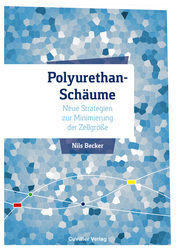| Departments | |
|---|---|
| Book Series (96) |
1378
|
| Nachhaltigkeit |
3
|
| Gesundheitswesen |
1
|
| Humanities |
2365
|
| Natural Sciences |
5406
|
| Mathematics | 229 |
| Informatics | 319 |
| Physics | 980 |
| Chemistry | 1363 |
| Geosciences | 131 |
| Human medicine | 243 |
| Stomatology | 10 |
| Veterinary medicine | 108 |
| Pharmacy | 147 |
| Biology | 835 |
| Biochemistry, molecular biology, gene technology | 121 |
| Biophysics | 25 |
| Domestic and nutritional science | 45 |
| Agricultural science | 1004 |
| Forest science | 201 |
| Horticultural science | 20 |
| Environmental research, ecology and landscape conservation | 148 |
| Engineering |
1793
|
| Common |
98
|
|
Leitlinien Unfallchirurgie
5. Auflage bestellen |
|
Advanced Search
Polyurethan-Schäume - Neue Strategien zur Minimierung der Zellgröße (English shop)
Nils Becker (Author)Preview
Table of Contents, PDF (60 KB)
Extract, PDF (1.6 MB)
Energy saving is the primary measure for sustainable protection of resources. For developing highly efficient heat insulating materials polyurethane is an ideal starting material due to its cost-efficiency and availability for large-scale industrial production. Generally, heat transfer in insulation foams consists of three components: thermal radiation, thermal conductivity through the matrix and thermal conductivity through the pore gas. The contribution of the latter to the entire heat transfer increases with decreasing foam density and represents more than two thirds in commercially available insulation foams with common densities of 30-90 kg/m3. Simultaneously, reducing the pore size to a submicron level leads to a considerable decrease of heat conductivity due to KNUDSEN-diffusion. For the production of these foams a high number density of blowing agent pools in the starting material is required. To achieve this goal, two approaches have been exploited: The Principle of Supercritical Microemulsion Expansion (POSME), which is based on microemulsions, an Nanofoams by Continuity Inversion of Dispersions (NF-CID), where nanaoparticles are foamed. With regard to a prevention of foam aging in the course of the POSME-process, first the nanostructures of foamable microemulsions containing polyol and supercritical carbon dioxide were investigated by small angle neutron supercritical fluid were exchanged, which led to a structure enhancement of the system, With these microemulsions a transfer of the nanostructure to a PUR-foam comes into reach. A new way to generate a sufficient number of nanopools in the polymer matrix is the Reactive Mixture N2-procedure (REMIX-N2) for thermoset polymer foams, based on NF-CID. In this process close-packed, small particles of a homogenous, polymerizing reactive mixture, which have not completely reacted yet, are prepared. In this way polyurethane and polyepoxide foams with pore sizes in the lower micron range were obtained. In a similar way foams with pore sizes of a few microns to less than 500 nm were produces, using thermoplastic polyurethane particles and mixtures of thermoplastic polyurethane and polystyrene particles. Thus, the production of PUR-nanofoams has become feasible based on the procedures mentioned above.
| ISBN-13 (Hard Copy) | 9783954048984 |
| ISBN-13 (eBook) | 9783736948983 |
| Final Book Format | A5 |
| Language | German |
| Page Number | 176 |
| Lamination of Cover | matt |
| Edition | 1. Aufl. |
| Publication Place | Göttingen |
| Place of Dissertation | Köln |
| Publication Date | 2014-12-17 |
| General Categorization | Dissertation |
| Departments |
Physical chemistry
|
| Keywords | Polyurethan, Dämmschaum, Nanoschaum, Knudsen-Diffusion, Mikroemulsionen, POSME, NF-CID, Wärmeisolierung |








